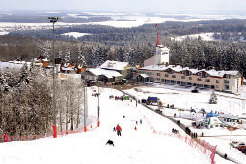January 23rd. In 1920, Honoured Figure of Arts of Belarus Piotr Danelia was born. He designed commemorative coins for Brest Fortress’ 20th anniversary of its defence during the Great Patriotic War, and Brest’s 950th jubilee.
January 24th. In 1919, Honoured Figure of Arts Ivan Kuznetsov was born — a composer. From 1953-1970, he worked at the Culture Ministry, and at Belarus’ Publishing House.
January 25th. In 1954, Belarusian Nikolay Astapkovich was born in Zhodino — a coach for canoeing and kayaking. He is an Honoured Master of Sports of the USSR and Belarus, and a world champion (1975, 1981 and 1983).
January 26th. In 1900, Belarusian poet Arkady Morkovka was born in the village of Zazerie, in the Pukhovichi District. He wrote poetic collections: Smoke of Life, Years Like Sails, and Poems.
January 27th. In 1935, People’s Artiste Zinovy Babiy was born. From 1963-1977, he was a soloist with Belarus’ State Opera and Ballet Theatre.
January 28th. In 1940, Belarusian writer Leonid Daineko was born in the Klichev District’s Dmitrovka. He wrote several poetic collections and novels, with some set to music.
January 29th. In 1900, Nikolay Yermolenko was born — a scientist, a Doctor of Chemical Sciences, a Professor, an academician and an Honoured Figure of Sciences of Belarus. He wrote over 370 scientific papers, researching high-molecular weight polymer expansion in mixed liquid mediums.
January 23rd. In 1997, the Belarusian President’s Administration was established.
January 24th. In 1895, the first electricity station came into operation in Minsk.
January 24th. In 1939, the BSSR State Picture Gallery was established, known as the National Art Museum of Belarus since 1993.
 January 24th. In 2005, Silichi Ski Resort opened in Logoisk, 30km from Minsk.
January 24th. In 2005, Silichi Ski Resort opened in Logoisk, 30km from Minsk.
January 25th. In 1972, the one millionth citizen was born in Minsk, making the Belarusian capital the 11th ‘millionaire’ city of the USSR.
January 26th. In 1586, Nesvizh received its Magdeburg Right.
January 26th. In 1927, the Belarusian Scientific-Research Institute of Agriculture and Forestry was founded in Minsk, operating in Zhodino since 1964 and known as the Belarusian Scientific-Research Institute of Agriculture and Forages since 1969.
January 26th. In 1990, the law on languages came into force, giving Belarusian language national status.
January 26th. In 1992, Belarus established diplomatic relations with Portugal and Japan.
January 26th. In 2000, Belarus’ first school of bell ringers opened in Minsk.
January 26th. In 2000, an agreement on the Belarus-Russia Union State came into force.
January 27th. In 1957, secondary school #24 (focusing on foreign language teaching) opened on Minsk’s Internatsionalnaya Street: currently, among the best schools in the country.
January 27th. In 1976, the Radzima (Motherland) Belarusian Society for Cultural Relations with Countrymen Abroad was founded.
January 27th. In 1992, Belarus established diplomatic relations with the UK and Chile.
January 28th. In 1577, the city of Mozyr acquired the right to self-govern and received its emblem: a one-head black eagle, with a silver plate on its neck — against a blue background.
January 28th. In 1920, the first session of Minsk District partisans (acting in the Polish occupants’ rearward) met in the village of Gatovo.
January 28th. In 1965, Kurasovshchina village became part of Minsk’s territory.
January 28th. In 1995, the heads of the governments of Belarus, Russia and Kazakhstan signed a memorandum on the Customs Union, a protocol and a programme of action to strengthen integration as part of the CIS Economic Union.
January 28th. In 2003, People’s Artiste of the USSR Vladimir Mulyavin was buried in Minsk’s Vostochnoe (Moskovskoe) cemetery.
January 29th. In 1864, Minsk authorities allowed merchant Rokhlya Frumkina to open a brewery on Alexandrovskaya Street (now M. Bogdanovich Street’s Olivariya brewery). Its building is a monument of 19th century industrial architecture.











